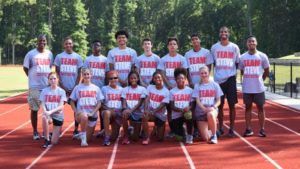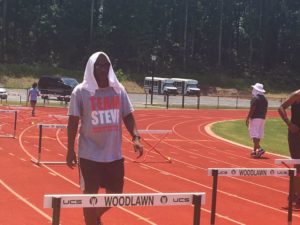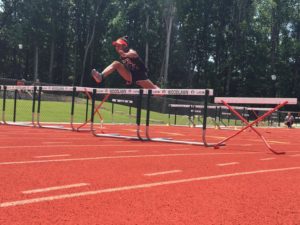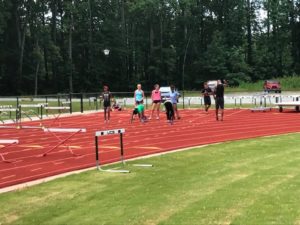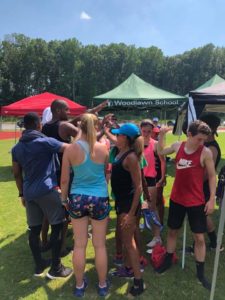Team Steve III
by Steve McGill
On June 9-10 I and my staff conducted the third Team Steve Speed & Hurdle Camp. For the first two – in November of 2017 and March/April 2018, we held the camps at the JDL Fast Track indoor facility in Winston Salem, NC. For our third one, we took it outside to a 400-meter oval. About an hour’s drive west of Winston Salem, in the small town of Mooresville, NC, there is a small private school called the Woodlawn School that houses one of the finest outdoor tracks that you’ll ever see at a non-collegiate facility. The surface is a soft rubber that is great for training on, as it doesn’t lend to shin splints or knee soreness.
[am4show not_have=’g5;’]
[/am4show][am4guest]
[/am4guest][am4show have=’g5;’]
How did we end up here? Well, I live in the Charlotte area, so I was looking to do a camp close to home, and I was looking to move the camp to an outdoor facility so that we had more room to work on the long hurdles. Woodlawn School is about five minutes down the road from Davidson College, and not more than 30 minutes from Johnson C. Smith University and UNC Charlotte, all of whom have mondo tracks. Mondo is great for racing, but not so great for training, and I knew we’d be putting a lot of pounding on the kids’ legs in the two days of the camp with constant drilling and block starts. The softer surface of Woodlawn, for our purposes, was therefore much more preferable. A colleague of mine at Davidson Day School, which is only about a 10-minute drive from Woodlawn School, suggested I contact the athletic director there. I did so, and he was more than willing to accommodate a track camp, as he is a track guy himself.
This camp had less attendees than the previous two, as many athletes who are still competing in the summer had a meet to attend or were saving their money for travel to meets later this summer. Still, even with the smaller numbers (we had a total of 13 campers), we had athletes from New Hampshire, Maryland, Texas, and Georgia, in addition to athletes with shorter commutes from South Carolina and North Carolina. The most fortunate aspect of the smaller camp is that it allowed us as coaches to provide the athletes with even more one-on-one attention than usual. Also, for the first time, Hector Cotto and I were able to work together with the athletes. In previous camps, I’d have him take charge of a group on one side of the track while I worked with another group on the other side of the track. This time, we were able to work side by side, which was not only a lot of fun, but also very helpful, as Hector is a very knowledgeable and enthusiastic coach from whom I learned a lot over the two days.
Besides Hector, Coach Kevin Howell, who helped out at both previous camps, was able to drive up from Savannah, GA on Sunday to add his expertise regarding block starts and sprint mechanics. Jenna Pepe, who has previously added her expertise in regards to sprint drills and strength training, was unable to attend due to job obligations. Finally, our all-around assistant was Garrison Rountree, a former high school athlete of mine who just graduated from North Carolina State University. Garrison helped with setting up hurdles and providing the bug spray, both of which proved to be invaluable!
Almost all of our campers this time around had very little hurdling experience, which was evident from the information they provided on the registration questionnaire, but was even more glaring once we got started with our first session. One of the things I pride myself on is being able to help any hurdler get better, from the absolute beginner to the national champion. Also, my attitude is always one of, if you’re here to get better, I’m here to help you get better. And all of the athletes at this camp came with a great attitude, an eagerness to learn, which made our jobs as coaches quite easy.
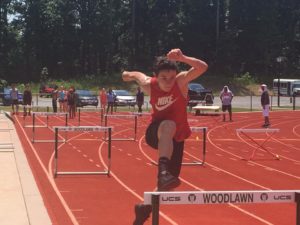
Evan Holland came all the way from New Hampshire to take part in Team Steve Speed & Hurdle Camp III. His trail arm got better by the end of camp.
In the camp’s first session, we spent a lot of time explaining dorsi-flexion of the ankle and running on the balls of the feet. We spent a lot of time on A-marches and A-skips, focusing first on just the lower body, then adding in the arms and upper body posture. As we explained to the athletes, ingraining proper sprinting mechanics is so important prior to even looking at a hurdle. From there, we moved to the trail leg fence drill, and that ended up taking up a huge chunk of the morning session. The idea of pushing off the back leg – which we emphasize in a big way when it comes to executing our style of cycling over hurdles – was quite foreign to almost all of the athletes. Knowing that I would eventually want to teach them the marching pop-over drill (which is all about pushing off the back leg), I couldn’t let them cheat the push-off in the fence drills. One thing I learned while teaching them the fence drill is that many hurdlers really don’t know what it means to push off the back leg. Even when they thought they were doing it, many of them were just tapping the track, not really pushing. Once they did get in the habit of pushing off the track, then it was a matter of reminding them to drive the knee of the trail leg upward and forward while simultaneously opening the groin only as much as necessary to avoid contact with the crossbar. I think it would be safe to say we spent a good 30 minutes on the fence drill alone.
Although I’m not a fan of side drills, I felt that this group could benefit from them, so I next had them do side walk-overs on both the trail leg side and the lead leg side so that they could understand the function of each leg. The hurdles were ten feet apart for a three-step march. In one lane we had fold-up hurdles at 27 inches, and in the other lane the hurdles were at 30 inches, 12 feet apart.
The marching pop-overs came next. And yes, they were a disaster at first, as I had expected. But Hector and I stayed persistent in insisting that they push off the back leg while pushing the hips forward and keeping the lead leg bent at the knee. To our delight, the athletes caught on, and there were smiles on some faces when it clicked in their minds how easy it was to hurdle this way.
Later that day, in the afternoon session, we moved on to the cycle drill and then the quick-step drill. A lot of kids had trouble with keeping the rhythm. It was clear to me that most of them never did any hurdle drills. Hurdlers who drill often have no problem adapting their speed to the spacing. Athletes who hardly ever drill always take off too fast; they’re always racing. As I explained to them, when you’re in learning mode, the hurdles are lower (than race height) and you move slower (than full speed). You can’t break old habits and ingrain new ones if you do everything at race height and full speed.
On day two, we worked on block starts in the morning, and on long hurdle drills in the afternoon. For the block starts, we taught them from the ground up – how to set the pedals, how to back into the blocks, how to place the head and eyes, how to rise into set position. Prior to the block starts, we had them do falling starts and then three-point starts so that the blocks themselves wouldn’t come as a shock. Some of the athletes had never used blocks before, and some of those who had might’ve been better off if they hadn’t. By the end of the session, we were able to get the athletes to do block starts over the first two hurdles. It was amazing watching them pick up on our teachings and implement the information.
For the long hurdles, we first had them do some drills to work on leading with the weaker lead leg. As has always been the case, even hurdlers who had never hurdled with the opposite lead leg were able to pick up on it rather quickly. From there, we did some drills on the second curve, over four hurdles, with the hurdles randomly spaced. And we kept moving a hurdle here or there so that they couldn’t get into a rhythm. The purpose here was to get them in the habit of staying in attack mode and keeping their hands high even when they weren’t sure how many strides they would take between each hurdle nor which leg they would lead with. Finally, we ended the session, and the camp, with 100m sprints over the three hurdles on the second curve. This track has markings for 300m hurdles, so the athletes cleared hurdles 3, 4, and 5 of that race, starting at the 200m start line and finishing at the 100m start line.
So we got a lot of work in over a two-day period. As I told the athletes, we taught them six weeks worth of material in two days. The purpose of a camp is never to solve all technical flaws in one fell swoop, but to expose flaws and to establish fundamental principles that the athletes can continue to build on once they get back home, now armed with the knowledge of how to address their flaws and train more effectively. And whether we have 45 kids or 15 kids, that is our aim at Team Steve.
[/am4show]
